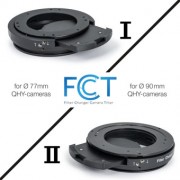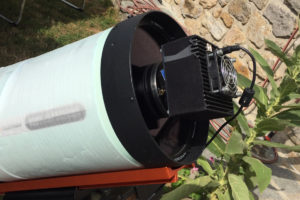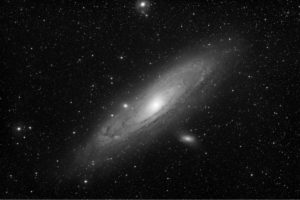
Especially for the RASA 8, we are developing the Baader FCCT a filter changer with tilting mechanism for the largest possible field of view. We will show a prototype this year on the AME fair. Read more about our highlights for this exhibition
The FCCT is now available!
Before the sales launch of new high-end telescopes, the first models go to experienced testers who check them for their possibilities and weaknesses. We asked Michael Jäger, one of the most successful comet hunters and photographers, to test the RASA 8" - Rowe-Ackermann Schmidt Astrograph. Such a fast telescope with short focal length and large field of view is perfect especially for sky surveillance.
Together with the telescope, Michael Jäger also received a filter changer which was fitted to the RASA 8: The
 Baader FCCT (Filter Changer Camera Tilter) for RASA 8" and QHY cameras
Baader FCCT (Filter Changer Camera Tilter) for RASA 8" and QHY cameras (various versions available)
lets you use filters as well as collimate filter and camera to the light path of the telescope.
Baader FCCT (Filter Changer Camera Tilter) for RASA 8" and QHY cameras
Baader FCCT (Filter Changer Camera Tilter) for RASA 8" and QHY cameras (various versions available)
lets you use filters as well as collimate filter and camera to the light path of the telescope.
These filters were not yet available for his first tests, but the colour shift is no problem with a monochrome camera. Thus, Michael Jäger could easily create a mosaic of the North America Nebula (NGC 7000) and the Pelican Nebula (IC 5070/5067) with nine segments, each with exposure times of 30-40 minutes. All in all, he used an exposure time of five hours. All he needed to do to create the final image was simply rotate the single frames, so that they fittet together.
Not only the distortion-free field is impressive, which made it easy to combine the mosaic, but also the relatively short exposure time beause of f/2. A telescope with f/2.8 would need twice as long to gather the same amount of light, and f/4 would double the time again.
Too much theory? Just take a look at the image of the Pelican Nebula by Richard Galli on www.nightpixels.net. For this image, full twelve hours of gathering light were necessary – with a Apogee Alta U16000 and 3nm filter at a 300/2,8 camera lens which was stopped down to f/3.3.
Just compare the images!
Another small experiment of Michael Jäger with the RASA 8:

NGC 7000 with RASA 8, ca. 1 hour exposure time. With Baader Highspeed 7nm H-alpha filter and CCD camera.
In front of the Schmidt corrector plate is a protective glass, which is held in place by small ring which is screwed on. Just for fun, I removed this ring and connected an old Sigma 6303 (10x10 cm body) with the help of this 2" thread. So, I could even use a filter changer.
The 27,5x17,5mm-sensor is not especially small and shows a field of 4x2,5 degrees when used with the RASA. It is a fact: The telescope provides an almost flat field with very little vignetting for an image circle of 25mm. Only when you leave this image circle, you see the effects of the smaller corrector.
After a rough collimation you can already estimate that the large field of view of this telescope can really be used completely.
So, even cameras with an APS-H sensor (28x18mm) should work, although only APS-C with 22,5x15mm is recommended. I was surprised that the stars didn't suffer too much from the large obstruction.
An image with 10x4 minutes Blue, 10x3 minutes Green and 4x6 minutes Halpha 3,5 nm (Highspeed-Filter).
This way, the dust is toned down a bit, and the structures are better to see, although the focal length is quite short. The only problem is that the large camera body causes some halo around bright stars, which needs to be removed digitally. .
For this image I left some of the halo near the star at the top; in the original file it is quite bright















I have a RASA 8 and am using 2" mounted filters. Is the filter changer /tilt corrector available?
Thank you
Hoping Baader can make a product like a EASY TO ADJUST tilt plate for the RASA 11 with Baader UFC. Most of us using the UFC are experiencing camera train tilt issues with no easy adjustment. = (
Yes, we have an UFC Tilt Adapter for RASA 11 and RASA 36 in the works. This however will still take another couple of months.
And for RASA 8?
Especially for the RASA 8 we developed the Baader FCCT (Filter Changer Camera Tilter) which is now available.
When will the FCCT for RASA 8 be available?
The FCCT is now available: Baader FCCT (Filter Changer Camera Tilter) for RASA 8 and QHY cameras